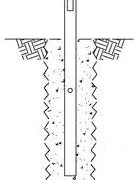Fiberglass Light Poles
NOT ALL LIGHT POLES METAL
Composite light poles, also known as fiberglass , is one of those light pole materials not commonly thought of. When we think of fiberglass, we think of small row boats to wakeboard boats. Fiberglass was first used as home insulation in 1930, and combined with polyester resin in 1935. The first fiberglass dingy was made in Ohio in 1942 (Uses of Fiberglass, Johnson). Its light weight, and sturdy structure was improved and is now used in automobile body sections, aircraft parts, and light poles.
INSTALLATION
 Fiberglass poles can be bolted to a footing or buried directly into the earth, known as direct bury. Direct burial means that the pole is buried directly into the earth, like standard telephone poles. When a light pole is installed using this method, the hole is dug, the pole is set and wired, then the hole is backfilled with the original material or concrete, depending on the specifications of the pole manufacture. This method can drastically lower the installation time when compared to the traditional method of pouring a footing, letting it dry, then installing the pole.
Fiberglass poles can be bolted to a footing or buried directly into the earth, known as direct bury. Direct burial means that the pole is buried directly into the earth, like standard telephone poles. When a light pole is installed using this method, the hole is dug, the pole is set and wired, then the hole is backfilled with the original material or concrete, depending on the specifications of the pole manufacture. This method can drastically lower the installation time when compared to the traditional method of pouring a footing, letting it dry, then installing the pole.
SOME FIBERGLASS DIFFERENCES
Steel poles are the most common poles on the market, but if they are not installed correctly, they rust and fall. Aluminum poles and galvanized steel poles do not corrode, but they are expensive. Fiberglass poles are priced slightly above steel poles, and do not corrode like traditional poles.
Fiberglass poles are up to 70% lighter than steel and aluminum poles (LightMart.com). This makes moving and installing fiberglass poles much easier than any other type of pole. Being non-conductive, fiberglass poles are also fully insulted.
MANUFACTURING
Fiberglass poles have two main components: fiberglass and resin. The fiberglass cords are made of 2,200 fiberglass strands wound together. The cords are dipped in a polyester resin bath then wrapped, many at a time, around a mandril. The steel mandril is tapered and makes the shape of the pole. The mandril spins and pulls the fiberglass cords around itself. The automated systems adjusts the speed of rotation and angle of the fiberglass cords to adjust the strength of the pole. When the fiberglass pole is the desired length and thickness, the mandril is pumped with steam to start the resin curing process. Within a few hours, the pole has cured and is ready to be pulled off the mandril. Cold water is piped into the mandril to make the pole removal easier. The mandril was lubricated before the fiberglass was wrapped so now it slides off the mandril with ease. Next the pole is sanded to the customers desired finish and the excess material is cut off the top and bottom of the pole. An automated router cuts the hand hole, fixture mounting holes, and below grade electrical conduit hole. Finally the pole is painted or powder coated any color the customer desires.

Leave a Reply
Want to join the discussion?Feel free to contribute!